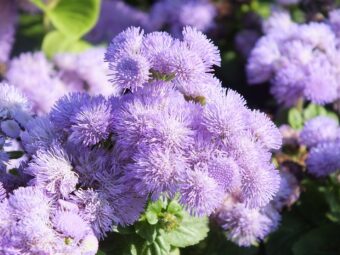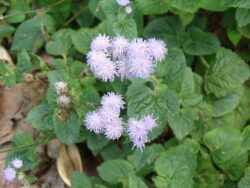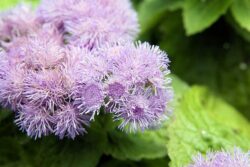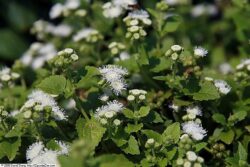In this article, we will discuss how to grow a wonderful and delightful, half-hardy bedding plant of Ageratum in Containers. This is a low growing plant that can grow up to 30cm tall and therefore suitable to be grown in containers. They are grown for the soft blue, purple, pink, red and white flowers that are produced en mass in summer.

The flowers are composed of tightly packed individual blooms that give an effect of a posy. The common name of floss flower is well earnt. These are great flowers if you want plants in the pastel colour scheme.
They are popular plants of the Aster family, which originated from areas of Africa and Southern United States, where Ageratum conyzoides (Billygoat Weed) is an invasive weed and has uses as a medicinal herb.
It is a popular bedding plant that is normally bought in cell packs in late spring for your summer bedding display. In containers, they make outstanding plants that can only grow up to 7.5cm tall but some varieties can reach a metre in height. The smaller varieties are often best suited for container display where it is best to plant them in the foreground or as an edging plant in troughs, window boxes or hanging baskets.
The leaves are mid-green and are either oval or lance-shaped that really suits the flowers that grow on top of them.
HOW TO GROW AGERATUMS IN CONTAINERS
As said in the introduction, you can either grow them from shop-bought cell packs or you can start them from seed 8 to 10 weeks before the last frost in late May. You can plant them directly in containers in late May but they will not produce flowers until late summer or early autumn.
TO GROW FROM SEED

Fill a seed tray full of seed compost and water until the compost is moist. On top of this, sprinkle the seeds onto the compost thinly and then do not cover them with any vermiculite or more sieved compost. This is because the seeds need light to germinate. Place a propagator lid on top and then place the seed tray on a heat mat or an electrical propagator until the seeds germinate (normally 5 to 14 days).
Once the seedlings are large enough to handle, prick them out and transplant them individually to cell packs full of multipurpose compost. When they are large enough and the danger of frost has passed, they can be hardened off and then planted outside.
GROWING FROM SHOP-BOUGHT CELL PACKS
Alternatively, you can buy them in flat packs or cell packs for planting directly in containers.
At this stage, both home-reared plants and shop-bought plants are treated in the same way.
Find a container that is within proportion to the size of the plant in question. You can grow them as sole specimen plants or mix them with other pastel colour plants in window boxes, troughs or hanging baskets.

Make sure the container you select has plenty of drainage holes and fill it with suitable multipurpose compost. Dig a hole that is slightly bigger than the root ball in the cell pack and place the plant in so that the top of the root ball is level with the compost surface- no shallower or no deeper.
Backfill with the growing media, ensuring that any gaps that remain are filled with more compost. Firm the plant in and water very well. Plant ageratum 15cn apart for short varieties, 30cm for tall one (more suitable at the back of containers)
At the same time as planting, add a slow-release fertilizer to give the plant an initial boost. Midway during the growing season, you will need to give a 2 weekly boost by feeding with a suitable liquid fertilizer.
If you notice the leaves are turning yellow, then this is a sign that the plant will need to be fed more. Ageratums tend to have shallow roots and because of this they can wilt and droop quickly. You must consistently water so that the top of the compost never gets dry and it feels moist at all times. This means in heatwaves, you will need to water almost daily. Water in the morning to stop the plant from developing fungal diseases.
BRIGHT LIGHT IS IMPORTANT
Place the container where it can get as much light as possible. It is best to plant short varieties with Petunias, Verbenas, Coleus and Pelargoniums. To help produce flowers for longer periods of time, you will need to deadhead regularly. Wet weather and too much water can cause the flowers to rot. If the plant gets too lanky, you can prune back to encourage them to flower again in a week or two.
PESTS AND DISEASES
If it is planted in the best location, it does not suffer from most pests and diseases. Potential problems include attacks from spider mites, aphids and whiteflies. This is best dealt with by using sprays of water from a hose or by the use of a systemic insecticide that will work with these pests.
Too much shade, packing plants too closely and high humidity can lead to powdery mildew. Prevention is better than the cure, so improve air circulation. Do not overwater as this can lead to root rot.
VARIETIES TO GROW

As you can see there are lots of varieties that can be grown. All of them are based on the species Ageratum houstonianum
that comes in shades of white, blue, pink and mauve.
In terms of blue flowers, you can grow ‘Adriatic’, ‘Blue Angel’, ‘Blue Mink’, ‘Blue Blazer’, ‘Blue Bouquet’ and ‘Blue Danube’.
In terms of pink flowers, you have ‘Bengali’ and ‘Fairy Pink’.
If white is your preference then you have varieties such as ‘Summer Snow’ and ‘White Cushion’.
CONCLUSIONS
In this article, we have discussed how to grow ageratums in containers that will bring wonder pastel colours to your display. As you can see they are easy to grow either from shop-bought plants or from those you grow from seed. You have plenty of choice as to what varieties to grow and they seem not to suffer much from pests and diseases.
All you need to do is feed regularly, water to keep the compost moist and deadhead to keep the plant in bloom. If you want a plant that looks good then this is one genus for you.
If you have any comments or questions, you want to make on growing ageratum in containers, please do so in the comment box below.
Happy Ageratum growing.
